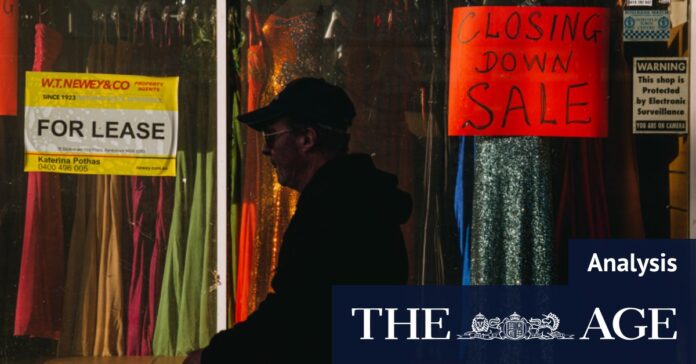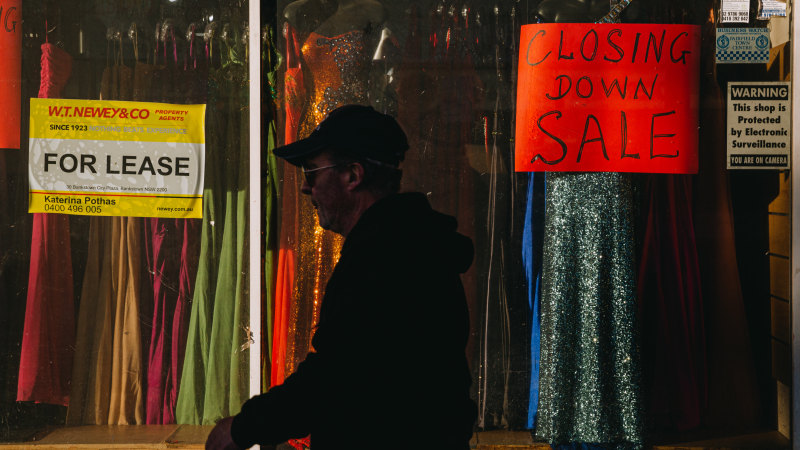[ad_1]
The state economy grew by a healthy 3.7 per cent in the year to June 2023, equal highest since Sydney hosted the Olympic Games in 2000. Sydney house prices have climbed around 10 per cent in 2023 despite higher interest rates.
But signs of a slowdown are becoming apparent. The jobless rate has climbed from those historic mid-year lows; the number of unemployed people in NSW has grown by almost 25,000 since June. Business surveys suggest there are more job losses to come.
Shoppers did flock to retail hubs this week for the traditional end-of-year sales, but card spending data published by the major banks showed consumer spending in the first half of December was relatively weak.
Dr Shane Oliver, AMP’s Sydney-based chief economist, warns the NSW economy is set to lose momentum in 2024.
“Things will slow down,” he says. “I’m not forecasting a recession, but it’s going to look a bit tougher.”
The Reserve Bank lifted interest rates five times in 2023, making it 13 increases since May 2022. The bank’s official cash rate, which flows through to variable mortgage rates, is at a 12-year-high.
Oliver says the economic impact of rate hikes tends to lag, meaning the full effects of those RBA decisions will be felt next year.
“As the impact of higher rates continues to flow through that leaves NSW a bit vulnerable,” he says.
A key reason for that vulnerability is that the high cost of housing, especially in Sydney, means NSW households carry more debt, on average, than anywhere else in the country. That makes the state disproportionately sensitive to higher interest rates.
A surge in overseas migration following the end of pandemic border closures has boosted demand in NSW during the past 18 months. But Oliver says population growth is now set to slow.
The weaker outlook for the NSW economy was underscored by a budget review released by the Minns government shortly before Christmas.
It forecast unemployment to climb to 4.5 per cent by next financial year, a level not seen in NSW since the pandemic lockdowns. The review predicted several years of slower growth and warned economic output per person would stagnate in NSW until 2025–26, due in part to the recent population surge.
“High inflation and rising interest rates continue to place pressure on household budgets,” it said. “Gross state product (GSP) per person is expected to remain broadly flat over the next two
years.”
Acting Treasurer Courtney Houssos says that addressing the high cost of living remains a priority for the NSW government.
“There is no doubt families, households and businesses begin 2024 under pressure, with inflation remaining a challenge, despite 13 successive interest rate rises,” she says. “It’s why our number one focus is cost of living.”
The health of the NSW government’s finances will be tested in 2024. The December budget review revealed the state’s financial position had worsened since Labor delivered its first budget in September.
It forecast that this year’s budget deficit will balloon to $9.5 billion – about $1.7 billion more than predicted only three months ago.
Houssos says the deterioration is being “driven primarily by factors outside of our control, including the federal government’s cuts to infrastructure spending, increased interest costs and a reduction in the GST pool.”
A small surplus is forecast for 2024-25, but the latest budget downgrades underscore how difficult it will be to balance the books in that timeframe, especially given the weaker economic conditions.
The state’s debt position has also worsened, with NSW’s net debt now forecast to hit $118 billion in June 2027, up from the $113.5 billion predicted in September. That will lift net debt to 13.1 per cent of the annual output of the state economy, a higher share than at any time in the past three decades.
The NSW government’s interest bill will rise rapidly as a result. Last financial year it paid $4.2 billion to service debts, but by 2026-2027, interest expenses will hit $7.7 billion – a rise of 82 per cent in four years.
The Reserve Bank may cut interest rates during 2024 as inflationary pressures finally ease. That will be especially good for Sydney given its high share of households with big mortgages.
But independent economist Chris Richardson warns one deeply entrenched structural problem will hamper the NSW economy in 2024 and beyond.
“If you pick the top three issues for NSW they are: housing, housing and housing,” he says.
The cost of housing – for buyers and renters – is so high in Sydney it is a growing drag on economic activity across the state, he says.
“If you think about the productivity of an economy as being strongly linked having the right people in the right place at the right time, then NSW is strikingly poorly set up, these days, to be as productive and hence as prosperous and as fair a society as we can be,” he adds.
Richardson says insufficient new housing is being approved in Sydney, especially in well-located areas, and when it is approved, expensive conditions are often attached that worsen affordability.
The city also lacks the transport systems “necessary to move people from reasonably priced housing to jobs” in an adequate timeframe.
Housing affordability has long been a problem in Sydney, but Richardson says it has now reached “bite us in the bum territory” as a broader economic challenge.
“Sydney is pricing itself out of being a competitive economy despite all the advantages that it has,” he says.
No easy solutions
Houssos says the NSW government is “focused on confronting the housing crisis”, which she says is a key source of the cost-of-living pressures affecting the community.
“Even if we have perfect housing policies … its well over a decade before we get reasonable housing rents and prices relative to incomes”.
Chris Richardson, independent economist
“Addressing the housing crisis will remain a challenge in 2024, but we have a comprehensive plan to increase housing supply, including our most recent announcements for medium-density housing at rezoned sites across Greater Sydney,” she says. “This includes the potential to build a new Metro station together with more than 25,000 new homes on the Rosehill Racecourse site.”
But Richardson, who is one of Australia’s leading economic analysts, warns there are no easy solutions to Sydney’s housing problems.
“The lack of an easy fix is one of the worst things about this,” he says. “Even if we have perfect housing policies – and people can argue what they are – it’s well over a decade before we get reasonable housing rents and prices relative to incomes. It’s taken many decades to screw this up and there is no magic wand.”
Young workers, crucial to every economy, are among the worst affected.
“The worry is there’s an entire generation which is increasingly disenfranchised,” says Richardson.
“They can’t see themselves either renting or owning housing that is anything like what they grew up with. And that is, increasingly, stoking resentment. I would say that is quite a challenge for the local economy.”
Start the day with a summary of the day’s most important and interesting stories, analysis and insights. Sign up for our Morning Edition newsletter.
[ad_2]
Source link



